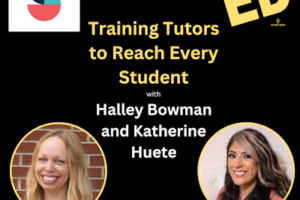
What If Geography Is the Curriculum We Need for the Future?
A student once told me, halfway through the term, “I thought this class would be about memorizing countries. But now I can’t stop seeing systems.”
He said it during a discussion about climate migration: how drought, policy, conflict and colonial borders collide. What he saw in that moment wasn’t just a map. It was a vision of power. A network of decisions, displacements and impacts that made the world unequal — and that might be reimagined.
That’s the moment I live for as a teacher. When geography shifts from trivia to transformation. When students stop asking, “Why do we need to learn this?” and start asking, “Why wasn’t I taught to see the world this way before?”

I teach large, lower-level courses at a public land-grant university. My students are engineers, business majors, first-generation college students, parents, veterans and dreamers. They don’t arrive expecting geography to matter to their future. But what I try to show them is that geography is already shaping it.
Not because they’ll become geographers, but because they are already living in a geographic world shaped by borders and systems, governed by infrastructure and inequality, and saturated with data and decision-making.
Geography Is Not What You Think It Is
When I tell people I teach geography, I often get one of two responses: a not-so-fond memory of a middle school map quiz; or polite confusion —“Wait, they still teach that?”
These reactions say a lot, not about geography, but about what we’ve allowed it to become in the public imagination. Geography, as a discipline, is understood through stereotypes: flags, capitals, coloring country maps, even the GIS mapping on our smartphones.
But at its best, geography is one of the most radical, essential and interdisciplinary ways of understanding our world.
It explores how systems of power, trade and technology shape our lives, who controls space and who is excluded, and how histories of colonialism still govern the streets we walk and determine the quality of the air we breathe.
Geography teaches us not just where things are, but why they are there — and what could be otherwise.
It’s the lens that reveals how a wildfire in Oregon, a supply chain delay in Malaysia and a surveillance policy in New York are not separate stories, but interconnected expressions in a global, dynamic system.
It’s time to reclaim that power.
Seeing Systems, Naming Injustice
If geography’s superpower is showing us how things connect, then its responsibility is showing us what those connections cost, and whom they cost the most.
Systems thinking is not neutral. It reveals how climate change doesn’t “affect us all equally,” but maps itself unevenly across lines of race, class and power. It shows us how a factory in the global North depends on a supply chain built from precarious labor in the global South. It explains how a “natural disaster” is not natural, but is the result of decades of policy, development and disinvestment.
In geography, we ask:
- Why do some communities flood repeatedly while others are protected?
- Why are data centers and toxic industries often located near the same neighborhoods?
- Who gets counted in a census, and who gets left out?
These questions aren’t theoretical. They shape life expectancy, mental health quality, mobility, and opportunity. Geography helps us see the structural in the spatial. And once students start seeing it, they can’t unsee it.
Teaching for Our Shared Future
In my classes, students don’t just learn about the world. They learn to navigate it with agency.
To help them build that agency, I introduce tools that encourage students to see patterns, ask deeper questions, and connect classroom learning to their lived experiences.
They build StoryMaps about food deserts and wildfire evacuation zones. They examine systems diagrams to map the social and ecological feedback loops of a single plastic bottle. They co-create AI policies that define ethical technology use in the classroom. These aren’t just assignments. They’re tools for making sense of the world. And the students know it. They often tell me it’s the first class that made them feel like their major, their background and their future fit together.
That’s geography, when it’s done right. But these insights aren’t only driven by the content; we build them into the classroom experience itself.
In my large-enrollment, 300-plus student courses, I use response systems not just to check comprehension, but to build morale and community. Students cheer when everyone gets a question right. We laugh when something surprising happens. These small, collective moments turn a lecture hall into a learning community.
I also rely on anonymous discussion boards, not just for shy students, but as a diagnostic tool to surface what might be called the “unknown unknowns.” It’s where students reveal confusion I didn’t know existed, ask questions they’re afraid to say aloud, and help shape how I adapt course content in real time. More than pedagogical hacks, they’re structural tools that re-center students as co-creators of meaning and momentum.
And perhaps most exciting, we’ve begun using AI tools not just as writing assistants or search engines, but as a site of inquiry. Students co-develop classroom policies around ethical AI use, and in doing so, they wrestle with questions of privacy, labor, bias, environmental cost, and employment futures. They begin to see themselves not just as users of technology, but as participants in shaping its trajectory.
This kind of engagement stands in contrast to what many faculty nationwide experience. According to the July 2025 AAUP report, the vast majority of college AI initiatives are implemented without faculty input, often increasing workloads and decreasing transparency. Their findings reinforce the need for local, participatory approaches, like those I experiment with in my classroom.
This is what curriculum for a shared future looks like: not just content about climate, tech or justice, but classrooms that invite students to inhabit complexity and act within it.
What the World Needs From Higher Ed
We live in an era of intersecting crises: climate instability, technological disruption, misinformation and disconnection. These aren’t isolated problems. They are symptoms of systems in imbalance. Solving them will require more than data. It will require a new way of seeing.
Geography offers that way, not as a niche subject, but as a connection across disciplines. It is a toolkit for understanding scale, power, place and possibility, all at once.
The world needs students who can hold complexity, think spatially, and act ethically, educators who can guide learning that reflects the world students actually live in and institutions that treat pedagogy as a strategy for cultivating a resilient, informed public.
Geography belongs at the center of that transformation, no longer a legacy subject, but a frontline framework.
Let me return to the student I mentioned at the start. By the end of the term, he wasn’t just seeing systems. He was sketching them, reworking them, and asking how he might change them, not later, now.
That’s what gives me hope.
Geography is not just a way of thinking. It’s a way of becoming more aware, more grounded, more connected. It’s about seeing your place in the world clearly enough to act in it and, we hope, to remake it.
Yes, geography still teaches maps. But the most important map is the one we carry forward: a map of systems, of justice, of the human future we’re all helping to create.
Source link


